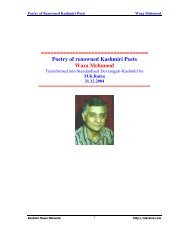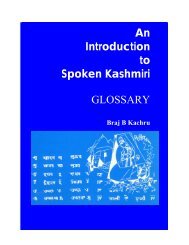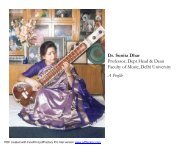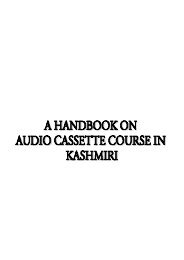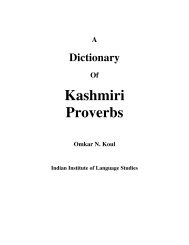Introductory Pages - An Introduction to Spoken Kashmiri
Introductory Pages - An Introduction to Spoken Kashmiri
Introductory Pages - An Introduction to Spoken Kashmiri
Create successful ePaper yourself
Turn your PDF publications into a flip-book with our unique Google optimized e-Paper software.
<strong>An</strong> <strong>Introduction</strong> <strong>to</strong> <strong>Spoken</strong> <strong>Kashmiri</strong><br />
by Braj B. Kachru<br />
Indo-European family of languages and thus, may be considered a branch of Indo-Aryan.<br />
Chatterjee argues that<br />
... <strong>Kashmiri</strong>, in spite of a Dardic substratum in it people and its speech, became a part of the<br />
Sanskritic culture-world of India. The Indo-Aryan Prakrits and Apabhramsa from the<br />
Midland and from Northern Panjab profoundly modified the Dardic bases of <strong>Kashmiri</strong>, so<br />
that one might say that the <strong>Kashmiri</strong> language is a result of a very large over-laying of a<br />
Dardic base with Indo-Aryan elements. [5]<br />
The second view is that <strong>Kashmiri</strong> belongs <strong>to</strong> a separate group—within the Indo-Aryan branch of<br />
Indo-European - called the Dardic (or the ) group of languages, the other two members of the<br />
group being Indo-Aryan and Iranian. Grierson suggests that<br />
... the Pis;ācha languages, which include the Shina-Khowar group, occupy a position<br />
intermediate between the Sanskritic languages of India proper and Eranian languages farther<br />
<strong>to</strong> their west. They thus possess many features that are common <strong>to</strong> them and <strong>to</strong> the<br />
Sanskritic languages. But they also possess features peculiar <strong>to</strong> themselves, and others in<br />
which they agree rather with languages of the Eranian family.... That language [<strong>Kashmiri</strong>]<br />
possesses nearly all the features that are peculiar <strong>to</strong> Pis;ācha, and also those in which Pis;ācha<br />
agrees with Eranian. [6]<br />
Three language groups are included in the Dardic family: the Kafiri Group, the Khowar Group,<br />
and the Dard Group. It is rather difficult <strong>to</strong> give the exact number of speakers of these three<br />
groups because political and geographical fac<strong>to</strong>rs have made it impossible <strong>to</strong> secure any reliable<br />
figures. Often the number of speakers and the name of a language varies from study <strong>to</strong> study.<br />
Traditionally, the above three groups have further been sub-classified according <strong>to</strong> the languages<br />
and/or dialects in each group. In three available studies [7], one finds extreme differences and<br />
confusions in both the names and number of languages listed under these three groups. These<br />
lists, according <strong>to</strong> Morgenstiern [8], are partially correct. Morgenstiern has also pointed out other<br />
inconsistencies pertaining <strong>to</strong> the names of languages and/or dialects as they appear in these<br />
studies.<br />
Table Showing the Speakers of Dardic Languages [9]<br />
Language (or Group)<br />
Kifiri Group 1<br />
Khowar Group 3<br />
Shina 856<br />
Brokpa 544<br />
Chilasi 82<br />
Gilgiti 76<br />
Number of<br />
Speakers<br />
Siraji 19,978<br />
© 2006 Braj B. Kachru (http://kachru.com) 2<br />
http://koshur.org/<strong>Spoken</strong><strong>Kashmiri</strong>



